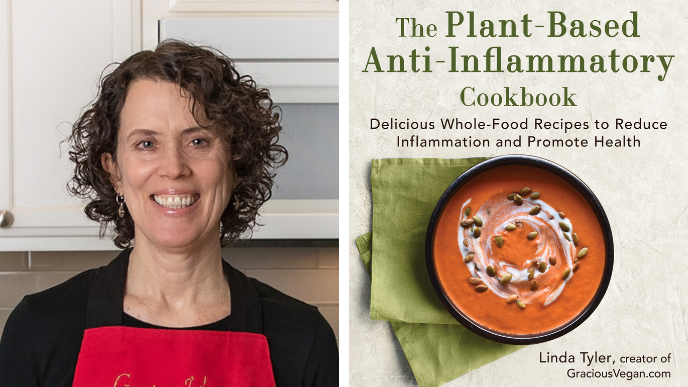
Linda Tyler’s New Anti-Inflammatory Cookbook Showcases the Power of Healing Foods
Inflammation can be likened to the bogeyman of the health and wellness realm: Most people know they want to avoid it, but they can’t quite define it, and there’s a lot of misinformation clouding the truth. Linda Tyler—who has dedicated years of research to understanding the diet-based triggers of inflammation and chronic disease—is here to clear things up. Her new cookbook, The Plant-Based Anti-Inflammatory Cookbook, coming February 6, provides an easy-to-understand manual for protecting your body from the harmful effects of inflammation through a whole-food, plant-based diet. We spoke with Tyler about how inflammation is often the harbinger of other long-term issues, which foods act as anti-inflammatory superstars, and how the new book teaches readers to heal from the inside out.
What prompted you to go whole-food, plant-based?
Linda Tyler: I became a vegetarian in college and then a vegan years after that. Both these choices were for animal welfare reasons, which is what resonated with me the most during that time. Then in 2015 I went to the Vegetarian Summer Fest in Pennsylvania, where there were a number of speakers, including Dr. T. Colin Campbell, talking about using a healthy plant-based diet for chronic disease prevention. I was amazed that a vegan diet could be so good for my health as well as good for animals and the planet. After that I started figuring out how to eat more whole foods, less oil, less sugar, less white flour, and it just evolved from there. It’s now been nine years since I started following a Forks Over Knives–style diet.
What inspired you to write an anti-inflammatory cookbook?
LT: I worked in nonprofits for nearly 30 years, and then I overlapped those last few years with creating whole-food, plant-based recipes and hosting cooking demos. Cooking has been a second career for me, but it’s really my true passion. I’m a researcher by nature, so when I first started hearing about inflammation and diet, I wanted to know what it was all about. There’s a history of osteoarthritis in my family, and as I've eaten more and more anti-inflammatory foods over the last few years, I’ve noticed a knuckle in my thumb that was developing an issue has since calmed down. I've noticed my skin is better, I have more energy, and my menopause symptoms have receded ever since I started eating anti-inflammatory foods. I became fascinated, and wanted to share everything I learned with other people in this new book.
Everyone wants to know: What exactly is inflammation?
LT: Inflammation is the result of your immune system reacting to irregularities in the body. So in that regard, it’s a completely natural process. The immune system reacts to bacteria or viruses or toxins that get into our system, [leading to] swelling, redness, and pain as the immune cells do their work to fend off invaders. That saves our lives. But the immune system also reacts to irregularities caused by our modern lifestyle. Immune cells can attack cholesterol that's accumulated on our arteries, which leads to an increased chance of strokes or heart attacks. They can also react to excess fat cells in our bodies and lead to hormonal disruptions. They can respond to oxidative stress in the body caused by sugar spikes in the blood, which makes things difficult for people who have Type 2 diabetes. And finally, immune cells can react to compounds in certain types of foods, such as saturated fat.
How does diet play a role in inflammation?
LT: Our diet can play a pretty significant role in dialing up or dialing down inflammation. Saturated fat encourages immune cell reactions and promotes leaky gut, which then lets other toxins into the bloodstream. High sugar spikes from processed foods are a big problem, and animal products can have bacteria called endotoxins that are also very pro-inflammatory. Avoiding foods that contain lots of oil, sugar, and white flour is one way to start taming inflammation. On the positive side, antioxidants found in plant foods really help to decrease the oxidative stress in the body, which helps prevent the immune system from overreacting. Berries, dark red or purple fruits, cruciferous vegetables, whole grains, beans, ginger, and turmeric are all particularly anti-inflammatory. I have a whole list of anti-inflammatory superstars in one of my introductory chapters, but in general, a whole-food, plant-based diet is much better than a standard American diet in terms of calming inflammation.
Tell us more about what people can find in your new anti-inflammatory cookbook.
LT: It starts with an in-depth but approachable look at what inflammation is on a biological level. I know whole-food, plant-based cooking can be intimidating, so I’ve included sections where I talk about cooking techniques like water-sautéing and batch cooking to help people navigate this style of cooking with more ease. And after that, I worked hard to create the best recipes I possibly could using the anti-inflammatory superstars.
You have a unique approach to formatting your recipes. Can you explain how they’re structured?
LT: The recipe instructions are formatted using the “action method,” which means the ingredients are grouped within the instructions and appear as they’re needed. I like this approach because it makes it easy to prep parts of the recipe before you make the whole thing. I would often do a little bit of meal prep before I left for work, and this style lets you see at a glance which ingredients could be prepped and stored together versus having to wade through the instructions to find out how and when they’re needed.
What do you hope readers gain from the book?
LT: I want them to have not just a better understanding of inflammation, but also the knowledge that anti-inflammatory ingredients are as close by as their local grocery store. None of these are expensive supplements or things you have to go to a health food store to get. And I also want people to see how many delicious ways there are to incorporate whole plant foods on their plate.
What would you tell a younger version of yourself now that you’ve acquired such expertise on anti-inflammatory diets?
LT: I certainly wish I'd known about plant-based eating when I was younger. In my teens and twenties I focused mostly on my weight and my running stamina as the only indicators of health, because that’s all I knew about. Now I understand much more how diet is related to our risk of chronic disease and the possibility of living with vitality as we age. When I was a kid I just ate what my parents put in front of me. It would be so much nicer if kids could grow up with a holistic view of what health really means so they can make choices about what to eat. My goal has always been to be a strong person inside and out, and I think healthy plant-based eating is integral to that goal.
Want to give anti-inflammatory eating a try? Check out Tyler’s Vegetable Tikka Masala recipe from The Plant-Based Anti-Inflammatory Cookbook to get a taste of how delicious and easy it can be!

About the Author

About the Author
Megan Edwards
Join our mailing list
Get free recipes and the latest info on living a happy, healthy plant-based lifestyle.
By providing your email address, you consent to receive newsletter emails from Forks Over Knives. We value your privacy and will keep your email address safe. You may unsubscribe from our emails at any time.